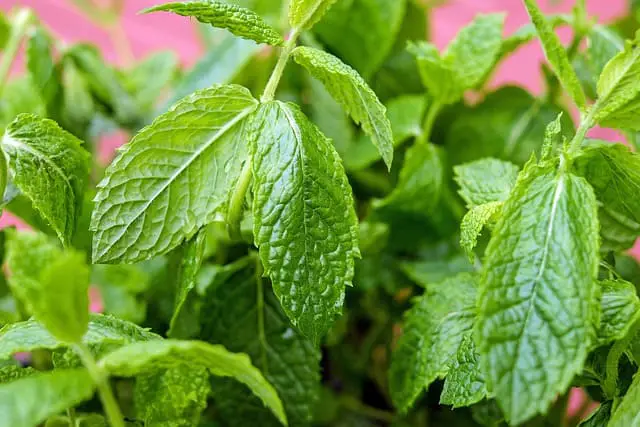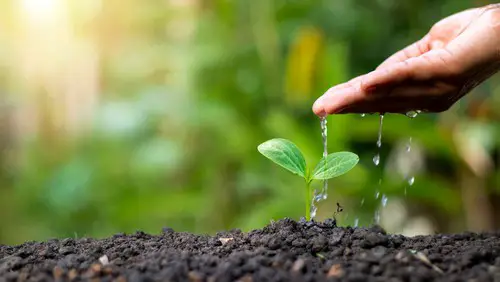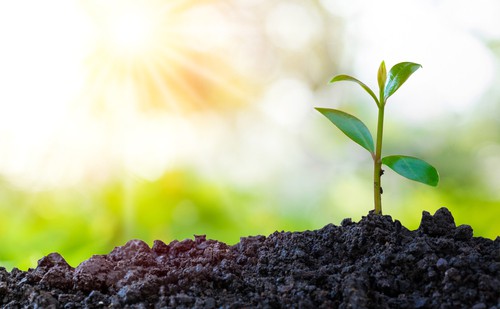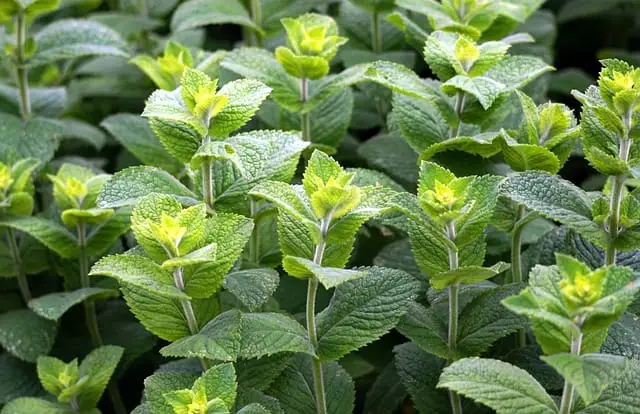Mint is a popular herb known for its refreshing scent and flavor. It is commonly used in cooking, teas, and even as a natural insect repellent. However, sometimes the mint plant leaves can turn brown, which can be a cause for concern for gardeners and home growers alike.
Mint plant leaves turning brown can be a sign of various issues, including watering problems, light and heat factors, diseases, and pests, soil and nutrition imbalances, and plant care and maintenance.
Understanding the common reasons for brown leaves on a mint plant can help you diagnose the problem and take appropriate steps to prevent and treat it.
Key Takeaways
- Brown leaves on a mint plant can be a sign of various issues, including watering problems, light and heat factors, diseases, and pests, soil and nutrition imbalances, and plant care and maintenance.
- Proper watering, light, and soil conditions are crucial for maintaining healthy mint plants and preventing brown leaves.
- Regular plant care and maintenance, including pruning, fertilizing, and pest control, can also help keep mint plants healthy and prevent brown leaves.
Also don’t miss:
- Mint Leaves Turning Brown and Crispy
- Mexican Heather Turning Brown
- Fairy Castle Cactus Turning Brown
Understanding Mint Plant

Mint is a popular herb that belongs to the Lamiaceae family. It is a hardy perennial plant that grows well in most climates. Mint is known for its distinct aroma and flavor, which makes it a popular ingredient in a variety of dishes, teas, and cocktails.
Mint plants can grow up to 2 feet tall and have square stems with leaves that are arranged in pairs opposite each other. The leaves are typically green and can vary in shape and size depending on the variety of mint.
Mint leaves are known for their refreshing taste and cooling effect that makes them a popular ingredient in many beverages.
Fresh mint leaves are often used in cooking and baking, as well as in making teas, syrups, and other beverages. They are also used in aromatherapy and as a natural remedy for various ailments.
Mint plants are easy to grow and care for, making them a popular choice for home gardeners. They prefer well-drained soil and partial shade, but can also grow in full sun. Mint plants require regular watering to keep the soil moist but not waterlogged.
Despite their ease of care, mint plants can sometimes develop issues that cause their leaves to turn brown. These issues can be caused by a variety of factors, including improper watering, pests, diseases, and nutrient deficiencies.
Mint Plant Leaves Turning Brown – 9 Common Problems
Mint plants are known for their refreshing aroma and taste, but brown leaves can be a common problem that gardeners face. In this section, we will look at some of the most common reasons for brown leaves on mint plants.
1. Overwatering
Overwatering is one of the most common reasons for brown leaves on mint plants. When the soil remains moist for too long, the roots cannot breathe and absorb nutrients from the soil.
This can cause the mint leaves to turn brown and wilt. To prevent overwatering, make sure to water the mint plant only when the top inch of soil is dry.
2. Underwatering
Underwatering can also cause brown leaves on mint plants. When the soil is too dry, the roots cannot absorb enough water and nutrients, leading to brown and crispy leaves. To prevent underwatering, make sure to water the mint plant regularly, especially during hot and dry weather.
3. Low Humidity

Mint plants thrive in high humidity environments, and low humidity can cause the leaves to turn brown and dry out. To increase humidity, you can mist the leaves with water or place a tray of water near the plant.
4. Fungal Infections
Fungal infections can also cause brown spots on mint leaves, which can eventually spread and cause the leaves to turn brown and fall off. To prevent fungal infections, make sure to keep the soil well-drained and avoid overwatering. You can also use a fungicide to treat the plant if it is already infected.
5. Pests
Pests such as spider mites and aphids can also cause brown leaves on mint plants. These pests suck the sap from the leaves, causing them to turn brown and dry out. To prevent pest infestations, make sure to keep the plant clean and free of debris. You can also use insecticidal soap to treat the plant if it is already infested.
6. Nutrient Deficiencies
Nutrient deficiencies can also cause brown leaves on mint plants. Lack of nutrients such as nitrogen, phosphorus, and potassium can cause the leaves to turn brown and yellow. To prevent nutrient deficiencies, make sure to fertilize the plant regularly with a balanced fertilizer.
7. Heat Scorching
Heat scorching can cause the edges of the mint leaves to turn brown and crispy. This can happen when the plant is exposed to direct sunlight or high temperatures. To prevent heat scorching, make sure to place the plant in a shaded area or use a shade cloth to protect it from the sun.
8. Limited Roots
Limited roots can also cause brown leaves on mint plants. When the plant is root-bound, the roots cannot absorb enough water and nutrients, leading to brown and crispy leaves. To prevent limited roots, make sure to repot the plant in a larger container when it outgrows its current pot.
9. Aging
Aging can also cause brown leaves on mint plants. As the plant gets older, the leaves naturally turn brown and fall off. To prevent aging, make sure to prune the plant regularly to encourage new growth.
Watering Issues

Mint plants are sensitive to watering, and improper watering can cause the leaves to turn brown. In this section, we will discuss the common watering issues that can cause brown leaves in mint plants.
Overwatering
Overwatering is one of the most common causes of brown leaves in mint plants. When the soil is constantly wet, the roots of the plant can become waterlogged, which can lead to root rot. Root rot can cause the leaves to turn brown and wilt.
To avoid overwatering, it is important to ensure that the soil is well-draining and that the pot has adequate drainage holes. It is also important to avoid watering the plant too frequently. A good rule of thumb is to water the plant when the top inch of soil feels dry to the touch.
Underwatering
Underwatering is another common cause of brown leaves in mint plants. When the plant is not getting enough water, the leaves can wilt and turn brown.
To avoid underwatering, it is important to establish a regular watering schedule. Mint plants prefer moist soil, so it is important to water the plant when the top inch of soil feels dry to the touch. It is also important to ensure that the pot has adequate drainage holes so that excess water can drain away.
Light and Heat Factors
When it comes to mint plant leaves turning brown, light and heat factors can play a significant role. Here are some sub-sections to consider:
Direct Sunlight
Mint plants prefer partial shade, so if they are exposed to direct sunlight for extended periods, it can cause their leaves to turn brown. Direct sunlight can cause the leaves to dry out and lose their moisture, leading to browning. Therefore, it is important to keep the mint plant in a shaded area, especially during the hottest parts of the day.
Heat Scorching
Heat scorching can also cause the mint plant leaves to turn brown. This can happen when the plant is exposed to excessively high temperatures, causing the leaves to dry out and turn brown. This can occur even if the plant is not exposed to direct sunlight.
To prevent heat scorching, it is important to keep the mint plant in a cool and well-ventilated area.
Diseases and Pests

Mint plants are susceptible to various diseases and pests that can cause the leaves to turn brown. In this section, we will discuss the common diseases and pests that affect mint plants and how to prevent them.
Fungal Diseases
Fungal diseases are among the most common problems that affect mint plants. Some of the most common fungal diseases that cause brown spots on mint leaves include mint rust, powdery mildew, and fungal rust. These diseases are caused by different types of fungi and can spread rapidly if not controlled.
To prevent fungal diseases, it is important to keep the mint plant’s leaves dry. Avoid watering the plant from above and instead water it from the base. Also, make sure that the plant has adequate air circulation and is not overcrowded.
If the plant is already infected with a fungal disease, applying a fungicide can help control the spread of the disease.
Pest Infestation
Mint plants can also be infested with various pests that can cause the leaves to turn brown. Some of the most common pests that affect mint plants include spider mites, aphids, and four-lined plant bugs. These pests feed on the sap of the plant, causing the leaves to wilt and turn brown.
To prevent pest infestation, it is important to keep the mint plant healthy and well-maintained. Regularly inspect the plant for signs of pest infestation and remove any infected leaves immediately. You can also use natural predators such as ladybugs and lacewings to control the population of pests.
Soil and Nutrition
Mint plants require well-draining soil to thrive. If the soil is too compacted or has poor drainage, it can lead to waterlogged roots, which can cause the leaves to turn brown. In addition, nutrient deficiencies can also cause brown leaves.
Nutrient Deficiencies

Mint plants require a variety of nutrients to grow and thrive. If the soil lacks essential nutrients, the plant may exhibit signs of nutrient deficiency, such as brown leaves.
Common nutrient deficiencies in mint plants include nitrogen, phosphorus, and potassium. A lack of nitrogen can cause yellowing of the leaves, while a lack of phosphorus can cause stunted growth and a lack of flowering. A lack of potassium can cause scorched leaf margins and brown spots on the leaves.
To prevent nutrient deficiencies, it is essential to provide the plant with a balanced fertilizer that contains all the essential nutrients. A nitrogen-rich fertilizer can help promote healthy leaf growth, while a phosphorus-rich fertilizer can help promote flowering and fruiting.
However, too much fertilizer can also cause problems, such as over-fertilization, which can lead to nutrient burn and brown leaves.
Poor Soil Drainage
Poor soil drainage can also cause brown leaves in mint plants. If the soil is too compacted or has poor drainage, it can lead to waterlogged roots, which can cause the leaves to turn brown. To prevent poor soil drainage, it is essential to ensure that the soil is well-draining and that the plant is not overwatered.
Mulching can also help improve soil drainage by helping to retain moisture in the soil while also improving soil structure. However, it is essential to avoid over-mulching, as this can cause salts buildup and lead to over-fertilization, which can cause brown leaves.
Plant Care and Maintenance
Mint plants are relatively low maintenance and easy to care for. However, proper care and maintenance are still essential to keep them healthy and thriving. In this section, we will discuss some of the essential care and maintenance practices to keep your mint plant healthy and prevent browning of the leaves.
1. Pruning
Pruning is an essential aspect of mint plant care. Regular pruning will help your mint plant to grow bushier and healthier. It also helps to prevent the plant from becoming too leggy and encourages new growth.
Prune your mint plant regularly by pinching off the tips of the stems. You can also prune it back to about 1/3 of its height in early spring to promote new growth.
2. Re-Potting
Re-potting your mint plant is necessary if it has outgrown its current container or if the soil has become compacted. When re-potting, choose a pot that is slightly larger than the current one and has proper drainage.
Fill the new pot with fresh potting soil and gently remove the plant from its current container. Loosen any constricted roots and place the plant in the new pot. Water the plant thoroughly and place it in a shady area for a few days to recover.
3. Other Care and Maintenance Practices

Apart from pruning and re-potting, there are other care and maintenance practices you should follow to keep your mint plant healthy and prevent browning of the leaves. These include:
- Proper drainage: Ensure that the pot has proper drainage to prevent the soil from becoming waterlogged, which can lead to root rot.
- Moisture: Mint plants require consistently moist soil, but not waterlogged. Water the plant when the top inch of soil feels dry to the touch.
- Air circulation: Good air circulation is essential to prevent fungal diseases and promote healthy growth. Ensure that the plant has enough space to grow and is not crowded.
- Humidity: Mint plants prefer high humidity. If the air is too dry, use a humidifier or place a tray of water near the plant to increase humidity.
- Sunlight: Mint plants require at least 6 hours of direct sunlight daily. If the plant is not getting enough sunlight, move it to a sunnier location.
- Sanitize: If you notice any signs of pests or diseases, sanitize the plant and its surroundings to prevent the spread of the problem.
- Natural aging: Mint plants have a lifespan of about 3-4 years. If your plant is older than this, it may be time to replace it with a new one.
By following these care and maintenance practices, you can keep your mint plant healthy and prevent browning of the leaves.
Prevention and Treatment
Mint plants are easy to grow and care for, but they can develop brown leaves due to several reasons, including stress, fungal spores, insect infestation, cold drafts, and more. Here are some prevention and treatment measures to help keep your mint plant healthy and thriving.
Prevention
Preventing brown leaves on your mint plant is the best way to ensure its health. Here are some tips to prevent brown leaves:
- Watering: Overwatering or underwatering can cause brown leaves. Make sure the soil is moist but not waterlogged. Water the plant when the top inch of soil is dry to the touch.
- Lighting: Mint plants prefer partial shade to full sun. Too much or too little light can cause brown leaves. Place the plant in an area with indirect sunlight, and avoid exposing it to cold drafts.
- Soil: Mint plants thrive in well-draining soil. Use a potting mix that contains perlite or sand to improve drainage. Avoid using garden soil, which can contain pests and diseases.
- Fertilizer: Over-fertilizing can cause brown leaves. Use a balanced fertilizer once a month during the growing season.
- Pest Control: Insect infestations can cause brown leaves. Regularly inspect your plant for pests, and treat them with insecticidal soap or neem oil.
Treatment

If your mint plant already has brown leaves, here are some treatment measures to help revive it:
- Pruning: Remove the brown leaves and stems to prevent the spread of disease. Use clean, sharp scissors to make a clean cut.
- Fungicides: If your plant has fungal spores, use a fungicide according to the manufacturer’s instructions. Copper-based fungicides are effective against fungal diseases.
- Insecticides: If your plant has an insect infestation, use an insecticide according to the manufacturer’s instructions. Neem oil and insecticidal soap are effective against many common pests.
- Stress Reduction: If your plant is stressed due to environmental factors, such as cold drafts or too much light, move it to a more suitable location. Avoid exposing the plant to extreme temperatures or direct sunlight.
By following these prevention and treatment measures, you can keep your mint plant healthy and thriving.
Frequently Asked Questions
Why are my mint plant leaves turning brown?
Mint plant leaves can turn brown due to various reasons such as overwatering, poor soil drainage, fungal diseases, pest infestation, sunburn, and over-fertilization.
Overwatering can lead to root rot, which can cause brown spots on the leaves. Fungal diseases such as mint rust can also cause leaves to turn brown.
Pests such as spider mites and aphids can damage the leaves, causing them to turn brown. Sunburn can occur when the plant is exposed to too much direct sunlight, and over-fertilization can cause the leaves to turn brown due to salt buildup in the soil.
How do I prevent my mint plant leaves from turning brown?
To prevent mint plant leaves from turning brown, make sure to water the plant correctly. Allow the soil to dry out slightly before watering again, and ensure that the soil has good drainage.
Avoid over-fertilization and use a balanced fertilizer. Plant mint in a location that receives partial shade to prevent sunburn. Keep an eye out for pests and fungal diseases, and treat them promptly.
What causes brown spots on mint leaves?
Brown spots on mint leaves can be caused by various factors such as overwatering, fungal diseases, pest infestation, and nutrient deficiencies.
Overwatering can cause root rot, which can lead to brown spots on the leaves. Fungal diseases such as mint rust can also cause brown spots. Pests such as spider mites and aphids can damage the leaves, causing brown spots to appear.
Nutrient deficiencies such as a lack of magnesium or iron can also cause brown spots on the leaves.
How do I treat mint rust?
To treat mint rust, remove all infected leaves and dispose of them in the trash. Do not compost infected leaves. Spray the plant with a fungicide that is labeled for use on mint plants.
Follow the manufacturer’s instructions carefully. To prevent the spread of mint rust, avoid overhead watering and plant mint in a location that receives good air circulation.
Is it safe to eat brown mint leaves?
Brown mint leaves are not harmful to eat, but they may not taste as good as healthy green leaves. If the brown leaves are due to a fungal disease, it is best to remove them and not eat them.
If the brown leaves are due to over-fertilization or sunburn, they may still be safe to eat, but they may not have the same flavor as healthy green leaves.
When should I remove brown leaves from my mint plant?
Remove brown leaves from your mint plant as soon as you notice them. This will help prevent the spread of fungal diseases and pests. Use clean, sharp scissors or pruning shears to remove the leaves, and dispose of them in the trash. Do not compost infected leaves.

Hey, I’m Lisa and I’ve been an avid gardener for over 30 years. I love writing, talking and living in the garden! Feel free to connect with me on my socials below


